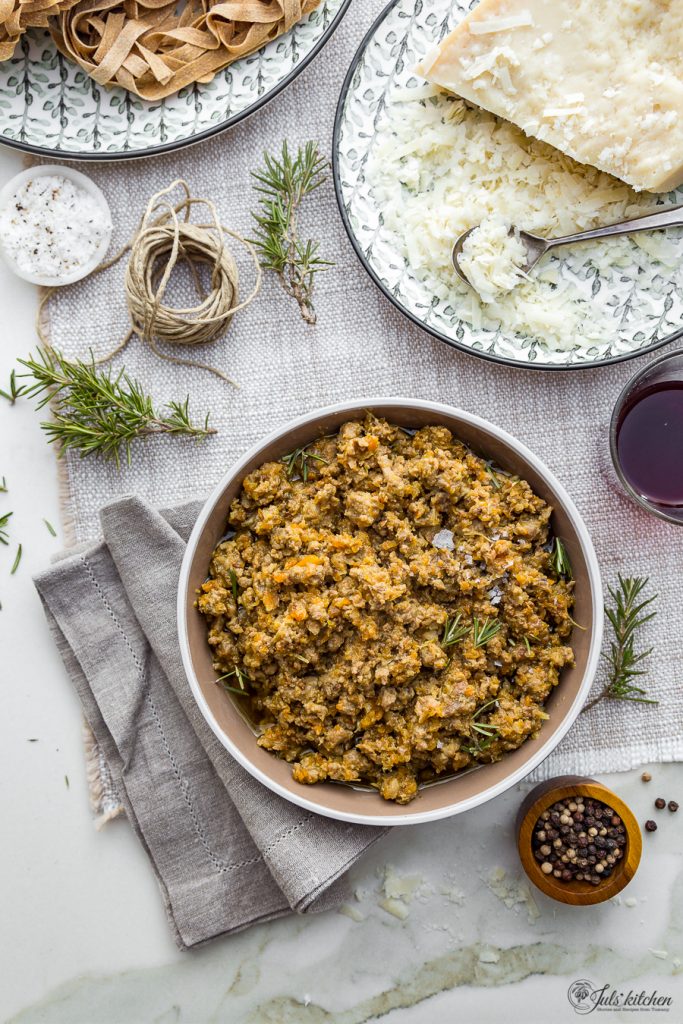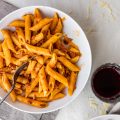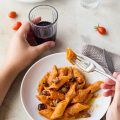Tagliatelle with pork ragù. Learning to cook, again
I’ve been making often ragù in these days. In one of the first cooking classes, just after the long-awaited snowfall, when the temperatures outside reached minus ten, we made my grandma’s classic ragù, chopping, stirring, simmering with wine and cooking slowly with tomato sauce. We dressed a bowl of home made pici with that, and all that icing cold weather and that snow seemed like the ideal backdrop to that pasta with ragù.
I prepared the meat sauce for a photo shoot, searching for that exact olive oil depth of red which reveals when the sauce is ready: that is also the perfect moment to boil the pasta.
Then I cooked the meat sauce for the blog, for today’s recipe: a hearty white pork ragù, with wild fennel and rosemary, where the acidity of the tomato sauce is replaced by that of white wine, which cooks the meat into a sauce.

I’ve been studying with voracity Salt, Fat, Acid, Heat di Samin Nosrat. It is hard to describe in a nutshell who Samin is: she comes from a family where food has always played a fundamental role, she learnt the cooking techniques in the kitchen of Alice Water’s Chez Panisse, then she landed in Italy at Benedetta Vitali’s trattoria in Florence and at Dario Cecchini’s butcher shop and restaurant in Panzano in Chianti. She studied journalism and food writing with Micheal Pollan. She is a cook, a teacher, a writer for the New York Times. She published her first book, Salt, Fat, Acid, Heat, an informative, amusing, illuminating cooking manual. Her idea is that we can cook consistently well if we learn to master these four cornerstones: salt, fat, acid and heat.
This book is constantly shaking my beliefs. I learnt to cook thanks to my grandma’s example and through lots practice, with this book I’m finally finding a sense in everything I do and going beyond my limits.
I made her spaghetti alle vongole using three very unusual ingredients for me: onions, butter and Parmigiano. The old Italian saying ’never put cheese on seafood pasta’ was completely turned upside-down. Yet she says she learnt this trick in a trattoria in the Chianti area, so very close to home. Well, I made this pasta for my dad’s birthday and the feedback was unanimous: outstanding. The ingredients were so perfectly balanced that you did not feel the Parmigiano as an intruder, but like the one thing that added an extra level of savouriness and acidity, that closed the circle of a perfect dish.
A birthday is not a birthday without a cake, so I made also her chocolate midnight cake, the first recipe I bookmarked in her book as I love baking with (olive) oil instead of butter. Another success, another recipe that pushed me to do things which were apparently weird at the beginning: all that salt! all that steaming coffee! The cake was moist, with an intense chocolate flavour, with a toasted, acidic note from the coffee and good cocoa powder. Salt, sweet, acid and fat perfectly balanced, once again.

This is why I love her book, this is why I love doing homework to put in practice what I’m learning. The amazing thing is that now I want to go through some of my staple recipes with this different perspective, and see if I can improve them, to produce consistently good food.
Samin, being a good teacher, pushes you to improve your skills. You never stop learning.

Tagliatelle with pork ragù
So back to this pork ragù, the last recipe developed for Luciana Mosconi.
I wanted a hearty sauce for the tagliatelle al farro, rustic, slightly nutty spelt tagliatelle: I opted for a pork ragù, without tomato sauce. I used scamerita, pork neck, which I finely minced, as a base. A generous amount of vegetables, as this is granmothers’ wisdom, or at least, of my nonna: you can get a rich meat sauce only if it starts with an abundant battutto.
Without tomato, the acidic note comes from white wine, poured in little by little to cook the meat. I checked the flavour several times, gradually adjusting the salt. Finally, the Parmigiano Reggiano, generously grated over the tagliatelle, gives the dish a further note of acidity and savouriness.
This pork ragù is my gift for these last days of winter, a rustic meat sauce for a Sunday, winter’s swan song before the next recipes which will welcome Spring again, in our life and in the kitchen.
Tagliatelle with pork ragù
Print Recipe Pin Recipe Share by EmailIngredients
- 3 medium carrots
- 2 stalks of celery
- 1 golden onion
- A few sprigs of wild fennel
- Two sprigs of rosemary
- Extra virgin olive oil
- Salt
- Pepper
- 600 g of minced pork meat
- 400 ml of white wine
- 250 g of tagliatelle
- Grated Parmigiano Reggiano
Instructions
- Make a battuto: finely chop the onion, celery, carrot, fennel and rosemary.
- Choose a medium-sized pot with a thick bottom. Cover the bottom of the pot with extra virgin oil, then scrape in the chopped vegetables and a generous pinch of salt. Cook the battuto over low heat for about ten minutes until it softens and becomes translucent and golden.
- Now add the minced meat and stir with a wooden spoon to mix the meat into the vegetables. Cook the meat over medium heat, stirring often, until it has absorbed all the liquid it will release. Continue to mix it, scraping the bottom and the sides of the pot, until the meat is golden brown. Taste and season with salt and pepper.
- Pour in the white wine: do this gradually, adding it in at least 4-5 times. Wait until the wine has been completely absorbed before pouring more wine. This step is crucial: it is the wine that will cooking the meat, turning it into a sauce. If we pour the wine all together, it will boil the meat, while, on the opposite, we want the ground meat to absorb the wine slowly, and to brown before we pour more.
- When the meat has absorbed all the wine and has assumed the appearance of a thick and full-bodied sauce, turn off the heat, taste one last time to adjust salt and pepper and set aside.
- Cook the tagliatelle in a large pot of boiling salted water, drain and toss with the sauce. Serve the tagliatelle with a sprinkling of grated Parmigiano.

Link Love
- If you feel like cooking your own ragù, here on the blog you can find several recipes which might meet your cravings: you can choose my grandma’s classical ragù, a guinea fowl ragù, a lentil ragù or even a vegetarian one, known as sugo finto, fake sauce. There’s a quick sausage ragù but also a slow cooked cinta senese ragù…
- Here you can read an interesting article on Samin’s book, with her recipe for chocolate midnight cake.
- On Food52, Skip Butter in Baking (Samin Says, Sometimes).
- On Splendid Table an interview with Samin, and her pasta alle vongole.










never heard of you but will try so Recipe’s
hello Sandra, you find many Tuscan and Italian recipes here on the blog, just have a quick tour and I am sure you’ll find something to appeal you! 😉
A wonderful winter staple and a dish that makes Sunday pasta ‘special’.
thank you Richard!
Hi Guilia,
I ate this in Tuscany a few weeks ago and like to give it a try today. Bit I was wondering… How much time does it take to absorb all the wine, in other words, how long do I put the meat on the stove?
Grazie! And have a great day!
Ciao Olivia (the Netherlands)
Hello Olivia, it all depends on the quality of your meat, it can be more or less watery, so pay a close look while the meat is sizzling. When you see there is no more liquid at the bottom of the pan, you can go on with the recipe!